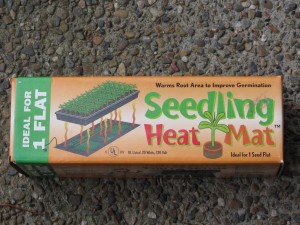This is the first in a series of posts about getting ready for spring planting. Today we’ve been having one of our rare rainy winter days so, of course, I’m dreaming of spring. Depending on where you live, it might be time to start your tomato, eggplant, and pepper seeds indoors so you can have healthy transplants to set in your garden after your final frost date. Play along with me as I prepare–I’ll picture all of you out there getting your hands in the soil and feeling alive after winter dreariness. Don’t worry if you don’t have much space–we’ll be creating a “one pot plot” later in the series!
Are you planning on having any of the above-mentioned plants in your garden (or in a pot)? It’s perfectly acceptable to buy transplants from your local nursery (we frequently do). But, you’ll have better luck finding those exotic or different varieties if you start your own seed. Seed packets are usually cheaper than plants too–especially if you and your friends share packets. These are heat-loving plants and they need a head start indoors in order to produce during the few hot months during the growing season most of us have.
0. Make a tentative plan. What do you have space for, what do you like to eat, how much can you eat/preserve/give away, and what realistically will grow in your climate/garden location?
1. Get your seeds. Some companies I like are Renee’s Garden Seeds, Baker Creek Heirloom Seeds, Seeds of Change, and Seed Savers Exchange (maybe try a SSE membership?) but check what else is out there. You might want to go for companies local to you, wherever you are. Check your local nursery, ask friendly neighborhood gardeners, browse the web. Try something new.
2. Read the seed packets. Once you’ve selected your seeds, look at the back of the packets for all the vital information printed there. For tomato plants look for whether it’s determinate or indeterminate (determinate tends to have one crop all at once on more compact plants–indeterminate is the opposite). The countdown to maturity doesn’t start until the transplants are actually in the garden so be aware of the length of your growing season. And check the date of the seeds–they remain viable for a few years if they’ve been stored correctly but don’t go too crazy with the date.
 3. Determine when you should plant. You’ll first need to find out about your average final frost date. Go to the National Climatic Data Center website for more information. To be on the extra-safe side, use the column with 10% probability for 32 degree F temperatures (for my area, that means March 20) then subtract the number of weeks indicated by the seed packet from the date you get from the Data Center. Yikes! March 20 minus six weeks for tomatoes = February 7 (that’s today). Luckily there’s definite wiggle room in the planting dates as long as you’re not too far off. Eggplant and peppers should be planted 8 weeks before the final frost date but there’s still time for me because I know March 20 is actually too chilly and windy for plants to go outside and do anything other than just sit there. Know your environment.
3. Determine when you should plant. You’ll first need to find out about your average final frost date. Go to the National Climatic Data Center website for more information. To be on the extra-safe side, use the column with 10% probability for 32 degree F temperatures (for my area, that means March 20) then subtract the number of weeks indicated by the seed packet from the date you get from the Data Center. Yikes! March 20 minus six weeks for tomatoes = February 7 (that’s today). Luckily there’s definite wiggle room in the planting dates as long as you’re not too far off. Eggplant and peppers should be planted 8 weeks before the final frost date but there’s still time for me because I know March 20 is actually too chilly and windy for plants to go outside and do anything other than just sit there. Know your environment.
In the next gardening post, we’ll start those seeds! Make sure to have your seeds, some seed starting medium (sterile, light potting soil; not real dirt), planting containers, and a light source (natural or otherwise) on hand. You may also want to have heat mats if your planting area is cool/cold. If you have questions, throw them in the comments. Although I’m by no means a Master Gardener (maybe later), I have been gardening for several decades. I’ll give answering you my best shot.
If you have questions, throw them in the comments. Although I’m by no means a Master Gardener (maybe later), I have been gardening for several decades. I’ll give answering you my best shot.
NB: As always, we make recommendations based on what we like not because we’ve been paid for our endorsements.
